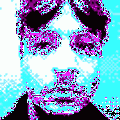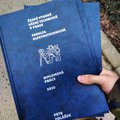Dropping an idea here. Light up and track a ping pong ball on a stick with a stationary camera using OpenCV using size as your depth cue. Re-create as a 3D model, displaying it with rotation around the center of it. Allow changing the color of the ball, duplicate in the model.
3D light painting in realtime.
Daren Schwenke11:16 AM
Suppose you could use IMU and a cell phone and guess the approximate location of the camera as well to eliminate the stationary bit.
 you can also use looming to determine distance
you can also use looming to determine distance
 that's how insects avoid obstacles
that's how insects avoid obstacles
 you mean using just a single camera then?
you mean using just a single camera then?
 sure, and low-res too
sure, and low-res too
 i'm curious how well using a single std. camera would work compared to stereo
i'm curious how well using a single std. camera would work compared to stereo
 one thing with looming is that it requires motion
one thing with looming is that it requires motion
 ahh
ahh
 works best when you move towards the object at a known speed
works best when you move towards the object at a known speed
 you basically see how fast it grows -- objects that are close grow faster than object that are far
you basically see how fast it grows -- objects that are close grow faster than object that are far
 could you simply use the diameter of the ping pong ball in pixels, from a single camera, and convert that to depth, which i thought is what @Daren Schwenke meant, or are there reasons that doesn't work well compared to 2 cameras
could you simply use the diameter of the ping pong ball in pixels, from a single camera, and convert that to depth, which i thought is what @Daren Schwenke meant, or are there reasons that doesn't work well compared to 2 cameras
 it's easier than stereo, because instead of finding the same object on two different photos taken at slightly different angles, you just need to find the same object at two different sizes
it's easier than stereo, because instead of finding the same object on two different photos taken at slightly different angles, you just need to find the same object at two different sizes
 @anfractuosity that requires pretty large resolution, though, or very consistent lighting
@anfractuosity that requires pretty large resolution, though, or very consistent lighting
 and knowing the size of the ping pong ball in reality too maybe?
and knowing the size of the ping pong ball in reality too maybe?
 ping pong balls have standardized size
ping pong balls have standardized size
 oh true heh
oh true heh
 i think ToF cameras sound pretty nifty, not sure how pricey they are though
i think ToF cameras sound pretty nifty, not sure how pricey they are though
 Kinect
Kinect
 the first one used a pattern i thought, is the 2nd one tof then
the first one used a pattern i thought, is the 2nd one tof then
 if you can control the hardware in the wand, there are easier ways to do this
if you can control the hardware in the wand, there are easier ways to do this
 like the wii rmote
like the wii rmote
 oh that uses ir i think?
oh that uses ir i think?
 and a sensor bar thing right
and a sensor bar thing right
 doesn't matter if the light is visible or not
doesn't matter if the light is visible or not
 oh actually the 'bar' is the light emitter i think actually
oh actually the 'bar' is the light emitter i think actually
 the important thing is it's modulated, so you can tell it from the background easily
the important thing is it's modulated, so you can tell it from the background easily
 just found this, which sounds v. interesting, will have to read the paper
just found this, which sounds v. interesting, will have to read the paper

https://www.youtube.com/watch?v=ZolWxY4f9wc
 The Algorithm
The Algorithm
 The problem is that it will work well when you move near the camera. As you get further from the camera, the precision will drop fast.
The problem is that it will work well when you move near the camera. As you get further from the camera, the precision will drop fast.
 yes
yes
 put the camera on the ball, and look for blinking light beacons in the anvironment
put the camera on the ball, and look for blinking light beacons in the anvironment
 environment
environment
 you will also get orientation info from it
you will also get orientation info from it
 and the farther they are, the more precision you actually get
and the farther they are, the more precision you actually get
 The problem is with any camera held by the user, it has to be oriented towards some reference to work. That limits the size of what you can create versus a ball on a stick pretty quickly. Also with putting multiple sources or points, then you have to deal with orientation feedback or the distance between your points is no longer your relative distance to the object.
The problem is with any camera held by the user, it has to be oriented towards some reference to work. That limits the size of what you can create versus a ball on a stick pretty quickly. Also with putting multiple sources or points, then you have to deal with orientation feedback or the distance between your points is no longer your relative distance to the object.
 A bigger ball would work and give you more accuracy at a greater distance.
A bigger ball would work and give you more accuracy at a greater distance.
 I just liked the small size too. :)
I just liked the small size too. :)
 button to select each color/turn on. On while held so you can stop your lines. Or select color via some interface then only light up when selected I guess.
button to select each color/turn on. On while held so you can stop your lines. Or select color via some interface then only light up when selected I guess.
 Hmmm.. how about a tetrahedron made with multiple balls on each vertex. Then the depth cue could be garnered from that. Probably the same level of accuracy increase as just using a larger ball, but then you could get orientation of the 'brush' as well.
Hmmm.. how about a tetrahedron made with multiple balls on each vertex. Then the depth cue could be garnered from that. Probably the same level of accuracy increase as just using a larger ball, but then you could get orientation of the 'brush' as well.
 Or... if you are tracking multiple balls, when two are lit and the same color draw that as a plane in space.
Or... if you are tracking multiple balls, when two are lit and the same color draw that as a plane in space.
 I did something similar for detecting distance to target with the Creeper project using the distance between your eyes. It was only accurate out to about 10ft at acceptable framerate. Tracking an object like a lit ball is a whole lot easier though and real-time at much better framerates.
I did something similar for detecting distance to target with the Creeper project using the distance between your eyes. It was only accurate out to about 10ft at acceptable framerate. Tracking an object like a lit ball is a whole lot easier though and real-time at much better framerates.
 and resolutions.
and resolutions.
 ooo.. in the virtual representation, you could have bins or areas in 3D space where you could position the target to select other features like line width, patterns, etc.
ooo.. in the virtual representation, you could have bins or areas in 3D space where you could position the target to select other features like line width, patterns, etc.
 I like the ball idea as well cause it puts the expensive bits remote from the user. You could literally use a flashlight, gels, and a ball to draw with no electronics needed on the end user side. Handing them out for an interactive thingy would not be cringe inducing.
I like the ball idea as well cause it puts the expensive bits remote from the user. You could literally use a flashlight, gels, and a ball to draw with no electronics needed on the end user side. Handing them out for an interactive thingy would not be cringe inducing.
 I just had a flashback to the MS 3D pipes screensaver.
I just had a flashback to the MS 3D pipes screensaver.

 MasterOfNull
MasterOfNull
Discussions
Become a Hackaday.io Member
Create an account to leave a comment. Already have an account? Log In.
hack the rpi 2040
Are you sure? yes | no